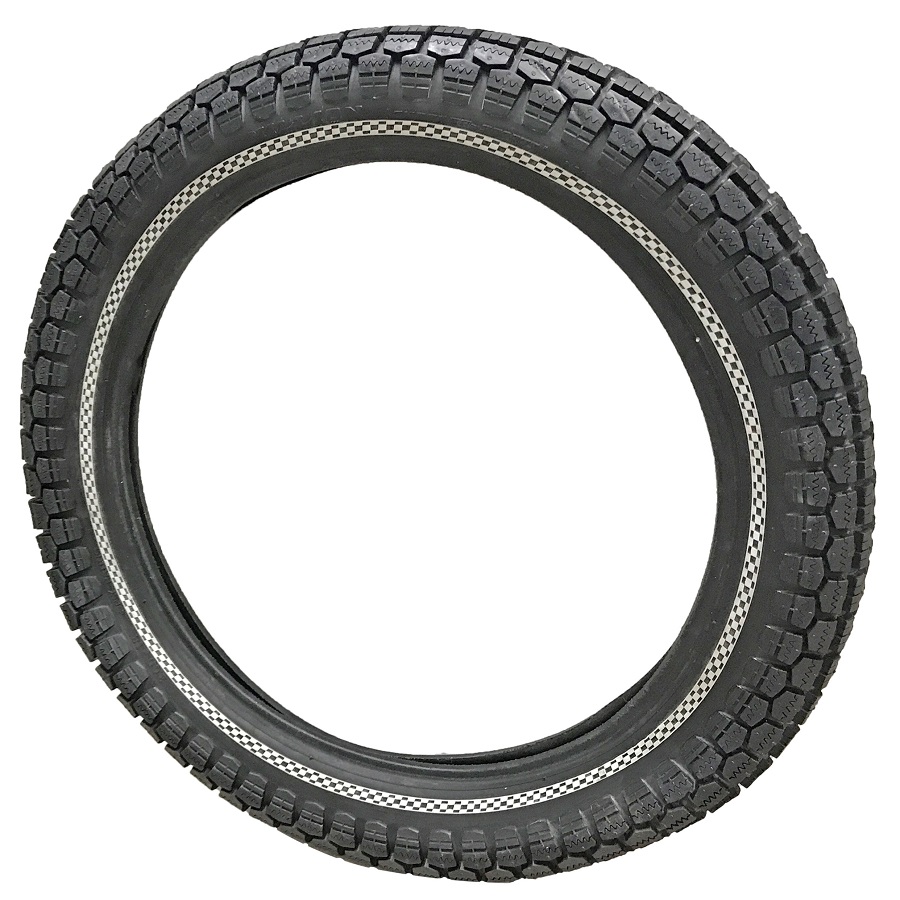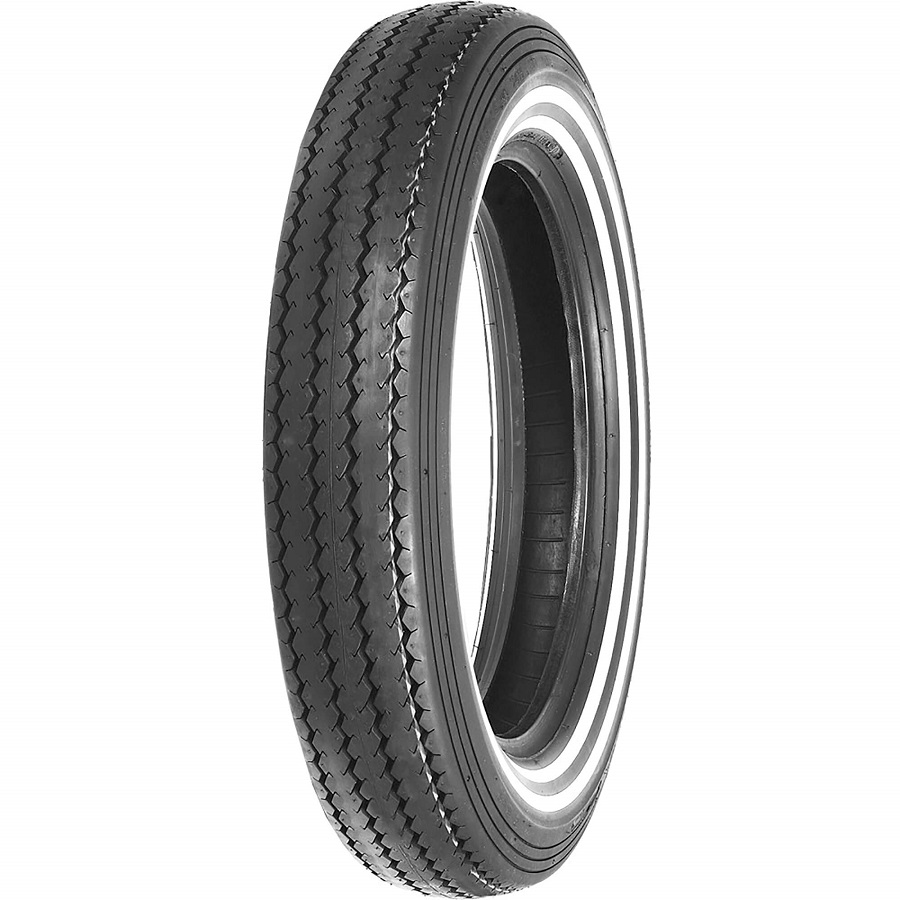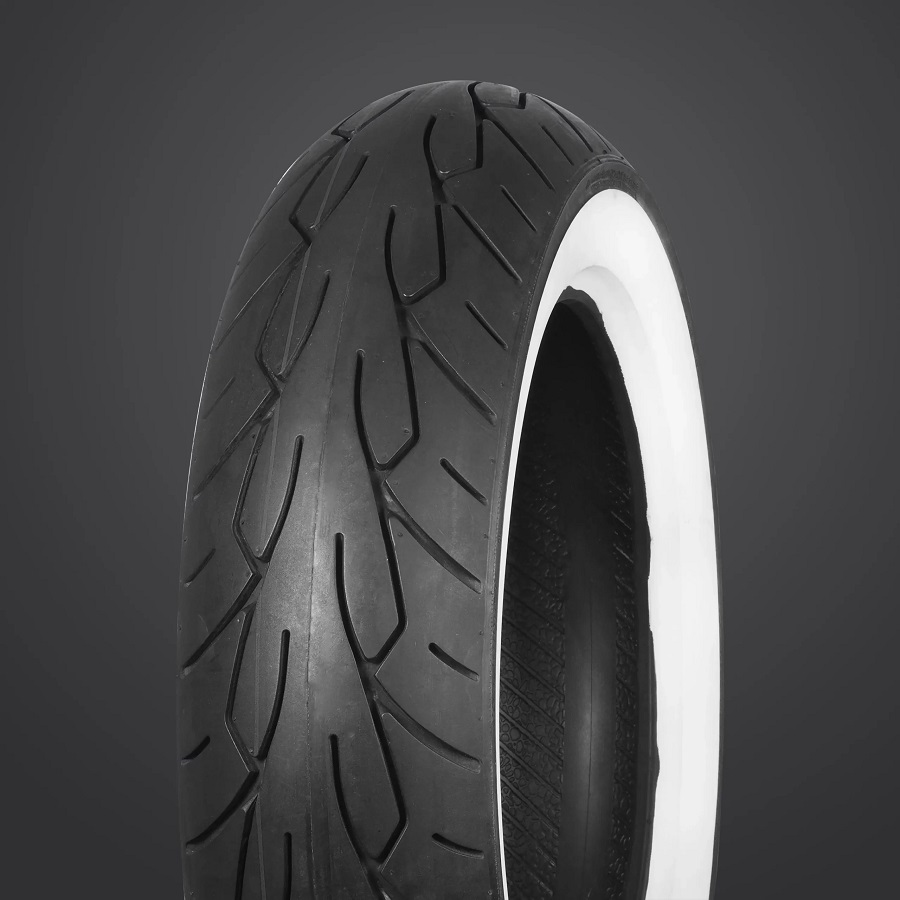The History of Whitewall Tires
Motorcycle whitewall tires carry a legacy far beyond mere function. Their story begins in the early 20th century. During that era, tire manufacturers made tires with natural rubber. This rubber was white due to zinc oxide, a substance used to increase durability. But these tires were not pure white; they had a creamy white shade. By the 1920s, carbon black was added to the tire treads. This was to improve strength and lifespan. The combination led to tires with white sidewalls and black treads. Thus, the first whitewall tires were born.
Over the years, whitewall tires became symbols of luxury and style. In the 1930s and 1940s, they were standard on luxury cars. High-end motorcycle makers then adopted them too. Whitewall tires became less common with the introduction of all-black tires in the 1950s. However, they remained popular among certain car and motorcycle enthusiasts. These riders often sought a classic and vintage look.
The love for whitewall tires lives on in today’s classic motorcycle circles. They bring a touch of history to modern bikes. While not as widespread as in their heyday, motorcycle whitewall tires hold a special place. They remind us of a time when they ruled the road. Owners who choose these tires often aim to capture the essence of a bygone era of motoring.
 Why Whitewall Tires are Popular among Classic Motorcycle Enthusiasts
Why Whitewall Tires are Popular among Classic Motorcycle Enthusiasts
Classic motorcycle enthusiasts often seek authenticity in their rides. Motorcycle whitewall tires are a key element in achieving this authentic vintage look. The stark contrast between the white of the sidewalls and the black of the tread captures the essence of the early 20th century motoring spirit. For many, it’s not simply about style; it’s about honoring the legacy of motorcycling history.
These tires represent a time when attention to detail and distinct design were paramount. They stand out in a sea of all-black tires, making a statement of individuality and a nod to the craftsmanship of the past. The aesthetic appeal of whitewall tires on a classic motorcycle cannot be overstated. They can transform a standard bike into a head-turning piece of art.
Furthermore, whitewall tires have become iconic in the classic motorcycle community. They serve as a badge of dedication to the culture and history of motorcycling. Many enthusiasts feel that whitewall tires are essential for a true classic restoration project. Riding on whitewall tires provides a sense of connection to the riders and builders of bygone days. This connection adds to the overall riding experience, which is highly valued by those who cherish motorcycle heritage.
Lastly, whitewall tires are often seen as collector’s items. They are sought after by enthusiasts who wish to keep the tradition alive. Owning a motorcycle with such tires is a point of pride. It shows a commitment to maintaining the original look and feel of classic bikes. For classic motorcycle enthusiasts, whitewall tires are more than an accessory; they are a tribute to the art of motorcycling.
How Whitewall Tires Enhance the Aesthetics of Motorcycles
Motorcycle whitewall tires add a striking visual impact to any bike. The classic look of these tires delivers immediate attention and timeless style. Their crisp, white sidewalls contrast sharply with black treads, making the wheels pop. This combination draws the eye and emphasizes the motorcycle’s contours. A bike with whitewall tires often seems more polished and attention to detail is evident.
Owners often pair whitewall tires with vintage designs, but they fit modern bikes as well. The tires create a bridge between past and present aesthetics. They are a bold choice that can define a motorcycle’s character. On a classic motorcycle, they enhance original features and respect the era of the bike. On a modern motorcycle, they offer a unique twist, setting it apart from others.
The impact of whitewall tires extends beyond individual bikes to entire scenes. At gatherings, a motorcycle with whitewall tires can stand out among the rest. Motorcyclists often see their bikes as extensions of their personalities. Hence, choosing whitewall tires reflects a rider’s love for nostalgia and individualism. In short, motorcycle whitewall tires serve as an aesthetic statement. They can turn a bike into a rolling piece of history and art.
The Process of Making Motorcycle Whitewall Tires
The making of motorcycle whitewall tires involves specific steps. First, manufacturers mix natural rubber with other materials. They add zinc oxide for durability, and for the white color. They combine this with carbon black, which strengthens the tire treads. The process results in the tires’ distinct two-tone appearance with black treads and white sidewalls.
Next, the material takes shape. Molds shape the tire to the correct size and pattern. During this stage, they ensure the sidewalls stay white, while the rest of the tire turns black. This stage requires attention to prevent any mixing of colors.
Once the tire is shaped, it cures in a heated press. This process solidifies the rubber. It fuses the materials together. The heat also ensures the longevity of the white color.
Finally, quality checks are crucial. Makers inspect each tire for visual defects. They ensure the whitewalls are pristine, and the treads are flawless. This step ensures each motorcycle whitewall tire is ready for use.
In conclusion, manufacturing motorcycle whitewall tires takes care and precision. It reflects a blend of art and engineering. It pays homage to the classic era while using modern techniques. These tires are then ready to add charm and character to any motorcycle.
Tips for Maintaining and Cleaning Motorcycle Whitewall Tires
Proper care is vital in keeping motorcycle whitewall tires looking their best. Here are some top tips for maintaining and cleaning these classic tire features to ensure they stand out as intended:
- Regular Cleaning: Clean your whitewall tires often. Use a mild soap and water with a soft brush. This removes road dirt and brake dust that can stain the white rubber.
- Specialized Cleaners: There are cleaners made just for whitewall tires. They help remove tough stains without damaging the tire’s surface. Make sure to follow the instructions on the cleaner.
- Soft Brushes: Always use a soft-bristled brush. This helps prevent scratches and scuffs on the white part of the tire.
- Rinse Thoroughly: After cleaning, rinse the tires well. Remove all soap and cleaner to avoid leaving residue.
- Dry Properly: Dry the tires with a clean, soft cloth. It prevents water spots on the white rubber.
- Storage: If storing your motorcycle, keep it in a cool, dry place. Avoid direct sunlight on the tires as UV rays can cause discoloration.
- Regular Inspection: Check your tires for signs of wear and tear. Look for cracks or discoloration in the whitewall area.
- Avoid Harsh Chemicals: Harsh chemicals can damage the rubber. Stick to motorcycle-specific or gentle products for cleaning.
With these tips, your motorcycle whitewall tires will continue to provide that classic appeal, reflecting the timeless design of a bygone era in motorcycling.
Selecting the Right Whitewall Tires for Your Motorcycle
Finding the perfect motorcycle whitewall tires can be thrilling yet challenging. Below are steps to guide you in the process:
- Size and Compatibility: Start by checking your motorcycle’s tire size. It must match the whitewall tires you plan to buy.
- Style and Era Match: Consider the era your motorcycle represents. Choose whitewall tires that complement your bike’s vintage charm.
- Quality and Brand: Look for reputed brands known for high-quality motorcycle whitewall tires. Reliable brands offer tires that last longer and perform better.
- Driving Conditions: Think about where you ride your motorcycle. Some whitewall tires suit dry roads while others handle wet conditions well.
- Budget Restrictions: Set a budget. Whitewall tires come at various prices. Stick to a range that won’t strain your finances.
- Tire Specifications: Review the load rating and speed rating. Ensure the whitewall tires meet your motorcycle’s demands for safety and performance.
- Local Dealers and Reviews: Reach out to local dealers. Read reviews on motorcycle forums. Feedback from other riders can be invaluable.
- Installation: Check if you can install the tires yourself or if you need professional help. Some tire shops offer installation services when you purchase.
Choose wisely when selecting motorcycle whitewall tires. The right choice can enhance your ride’s appearance and performance. Be sure to weigh all the factors to make an informed decision.
The Role of Whitewall Tires in Motorcycle Shows and Rallies
Motorcycle shows and rallies are all about showmanship and heritage. Motorcycle whitewall tires play a vital role in such events. Bikes with whitewall tires often steal the spotlight. They give spectators a glimpse of the past. At rallies, these tires signify a rider’s commitment to the motorcycle culture.
Standing Out in a Crowd
In a sea of motorcycles, whitewall tires make a bike stand out. They catch the eye with their stark contrast and shine. This effect draws people in for a closer look. The bikes become photo favorites at shows and rallies.
Tributes to Motorcycling Heritage
Riders with whitewall tires show a deep respect for riding history. This respect adds to the event’s nostalgic atmosphere. It sparks conversations about the golden era of motorcycling.
Winning Contests
During contests at these events, motorcycles with whitewall tires have an edge. Judges often see these tires as a mark of authenticity and dedication. This detail can influence their scoring in favor of the bike.
Creating a Community Feel
Whitewall tires help build a sense of community among enthusiasts. Riders with similar interests in classic styles bond over their shared passion. This camaraderie is a cornerstone of motorcycle shows and rallies.
In short, motorcycle whitewall tires enrich the motorcycle event experience. They celebrate the art of motorcycles and connect the community. Whether on display or in motion, these classic tires turn heads and warm hearts.
Advancements in Whitewall Tire Technology and Materials
As the demand for motorcycle whitewall tires persists, advancements in technology and materials have emerged. Manufacturers have improved the durability and quality of these classic tires. The development process has also become more eco-friendly.
Innovations in Rubber Compounds
In recent years, more resilient rubber compounds have been introduced. These provide longer tire life and better road grip. This means your tires stay white longer and perform better under various conditions. Additionally, new materials resist staining and yellowing from UV exposure.
Eco-friendly Manufacturing Processes
Production methods now often use sustainable resources. Many makers have cut down on wasteful practices. It reflects a shift towards more environmentally responsible manufacturing. This approach ensures that the legacy of motorcycle whitewall tires goes hand in hand with modern ecological awareness.
Enhanced Whitening Techniques
Whitening methods have also seen improvements. They now create a brighter, more consistent white that doesn’t fade quickly. Special coatings may also be applied to protect the white surface against dirt and brake dust.
Advanced Tread Patterns for Safety and Performance
Modern tread designs offer improved water dispersion. This increases safety in wet riding conditions. Updated tread technology also works to reduce road noise and enhance the riding experience. With these developments, your whitewall tires not only look good but also provide a comfortable, safe ride.
These advancements in motorcycle whitewall tire technology and materials ensure the blend of classic aesthetics with contemporary performance. Riders can enjoy the timeless style without compromising on safety or environmental considerations.


Leave a Reply